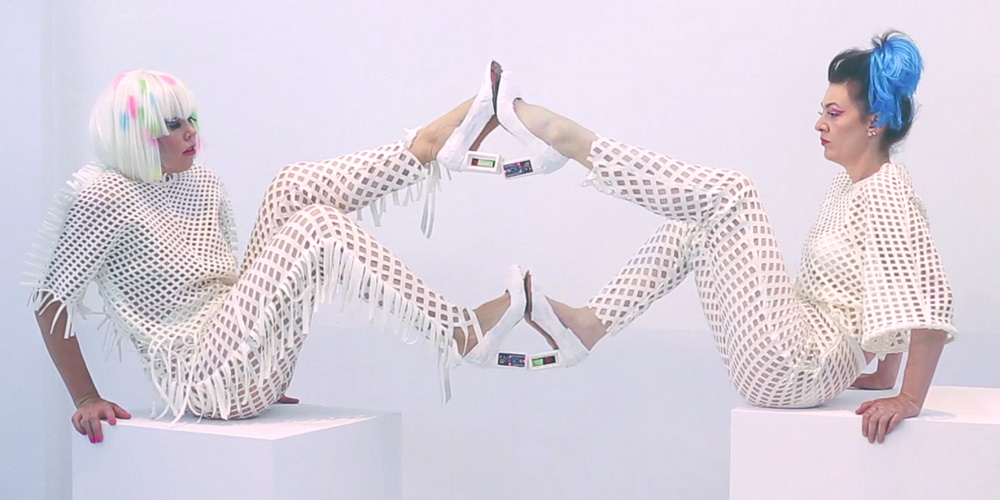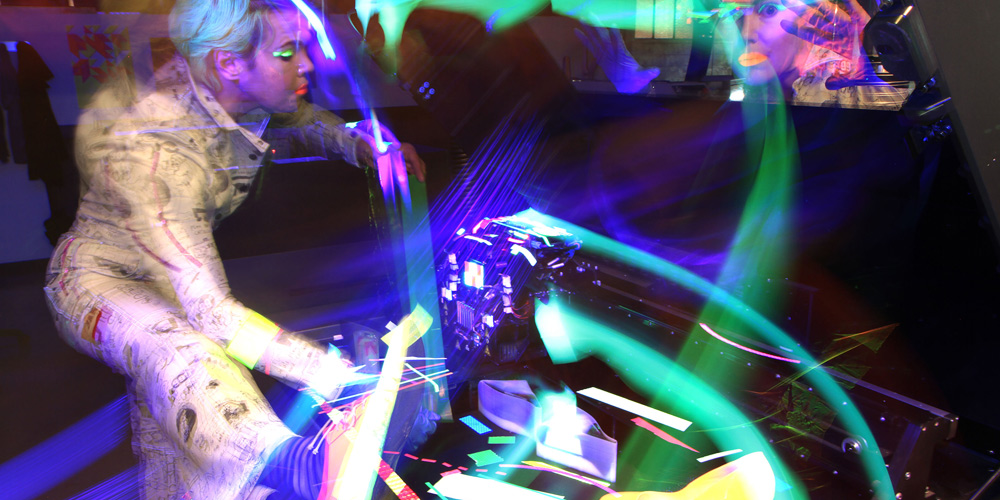
DEMAKING the High Heeled Shoe for Theatrical Audio Visual Expression
A project featuring choreographer Krõõt Juurak (EE/AT)
Alexandra Murray-Leslie (Chicks on Speed) (AU)
The Liberation of the Feet ist eine Performance mit modischen klangerzeugenden Anhängseln für Füße und will die physischen hochhackigen Schuhe und die damit assoziierten Stereotypen dekonstruieren. Die Füße – ausgestattet mit maschinellem Lernen, FM-Klangsynthese, Rapid Mixing Motion-Control, ausdrucksstarker Lichttechnologie und der richtigen Pop-Attitude – führen eine experimentelle Bewegungs-Taxonomie auf.
The Ars Electronica iteration of Computer Enhanced Footwear is kindly supported by Autodesk’s Pier 9 Artist in Residence program (3D print shop lead Gabrielle Patin, Program Manager Vanessa Sigurdson and Curator Sherry Wong). Sound and Motion Technology partner: Reactable Systems/Rapid-Mix motion-controlled sequencing and lighting technology partner: ProtoPixel.
http://reactable.com/
http://rapidmix.goldsmithsdigital.com/
https://www.autodesk.com/pier-9/residency/home
The Computer Enhanced Footwear project has been developed over the past five years, supported by global key institutions, teams and partners:
Creativity and Cognition Studios (Dr. Sam Ferguson & Dr. Andrew Johnston), Department of Engineering and IT, The University of Technology Sydney
Wekinator software, Dr. Rebecca Fiebrink @ Embodied AudioVisual Interaction (EAVI), Goldsmiths, University of London
Dr. Jonas Rubenson, Biomechanics Laboratory, Department of Kinesiology, College of Health and Human Development, The Pennsylvania State University and SymbioticA, The University of Western Australia
Prof. Ute Meta Bauer, NTU Centre for Contemporary Art, Singapore
The Computer Enhanced Footwear project is funded by The Australia Council for the Arts

Background
We can use our feet for more than just walking around and some people actually develop “extraordinary dexterity with their feet, not only using them to do everyday tasks, but even activities like painting or playing an instrument” [1]. Through training, it is possible for the feet to carry out complex creative tasks, beyond their normal everyday job as “stepping machines” [2]. Ingold suggests that a more grounded approach to the way we move as humans can open up new terrain in the area of embodied foot-based skills. Alexandra Murray-Leslie explores the development of these skills in the area of audio-visual performance and the related creation of audio-visual instruments created specifically for the feet.
The subject of bias against the feet was adopted by surrealists in their work, such as French philosopher Georges Bataille, who explored the conflicted relationship humans have with their feet in “The big Toe”: “The play of fantasies and fears, of human necessities and aberrations, is in fact such that fingers have come to signify useful action and firm character, the toes stupor and base idiocy” [3].
Such attitudes towards the feet, explain perhaps why so little care has been taken to create shoes that are good for the feet and do not restrict, deform or torture them. If shoes are able to deform and pain our feet, then this un-free experience will affect a performer’s sensory perception and influence their actions on stage. With more sensorial experience, the feet will be in a more expressive state. Shusterman’s proposal of somaesthetics [4] describes the beauty of experiencing one’s own body and to aesthetically pay attention to it, which will lead to a greater level of well-being and overall ability. Murray-Leslie suggests, the “aesthetic experience” [4] of the body can also be focused on the feet, a possibility she explores through the creation and use of a series of computer enhanced shoes and foot appendages, in different modes of performance. The aim is to find out which foot- wearables and context will best provide radical novelty in footwear design coupled with sound and movement.
The feet have also been neglected in the field of new interfaces for musical expression, with most musical instruments being designed for the hands. NIME tends to focus on practicalities for musical instruments, but she argues that fashion is another area which brings a rich history and range of techniques to bear. The appearance of a wearable instrument along with the social resonances of fashion objects such as high-heeled shoes brings another dimension to instrument design that Murray-Leslie believes has been neglected. Performers feet and shoes are rarely seen on stage, often obscured by fold back monitors and other equipment. In order to address this imbalance and find new avenues for creative expression she seeks to bring attention to the audio-visual expressivity of the feet with fashionable self made musical instrument shoes and temporary appendages.
Text excerpt taken from Murray-Leslie & Johnston, 2017:
http://homes.create.aau.dk/dano/nime17/papers/0057/paper0057.pdf
Quellen
[1] G. Downey (2009), “Loose your shoes: Is barefoot better”, https://neuroanthropology.net/2009/07/26/lose-your-shoes-is- barefoot-better/ accessed, 20th of September, 2014.
[2] T. Ingold (2004), Culture on the ground, The World Perceived through the Feet. Journal of Material Culture, 9, 3, 315–340.
[3] G. Bataille (1985), Visions of Excess: Selected Writings, 1927–1939 (Theory and History of Literature Vol 14), University of Minnesota Press, Minneapolis.
[4] R. Shusterman (1999), Somaesthetics: A Disciplinary Proposal The Journal of Aesthetics and Art and Criticism, 57, 3, 299–313.

